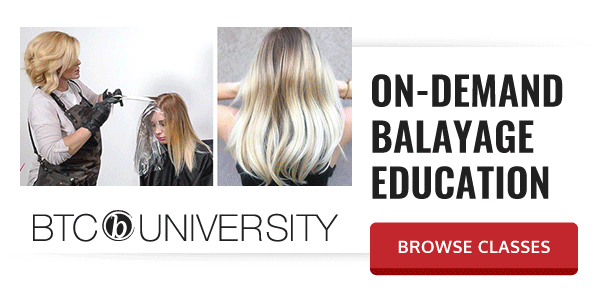Human Trafficking In Salons: Here’s What You Need To Know
Here’s What You Need To Know About Human Trafficking & Salons
Human trafficking isn’t something anyone, least of all hairdressers, should have to worry about. But, did you know salons and spas were the number one location for human trafficking in 2018? Shocking, right? January marks Human Trafficking Awareness month, so Wella Professionals and Hairdressers at Heart partnered together to bring awareness with #hairdressersagainsthumantrafficking.
We spoke to human trafficking advocate and hairstylist Haley Garber (@beautybyhaleygarber) to get more information on the subject and what you can do to help. Scroll down to learn more about how you can get involved!
View this post on Instagram
What Is Human Trafficking?
According to the Polaris Project, a non-profit focused on human trafficking awareness, “U.S. law defines human trafficking as the use of force, fraud or coercion to compel a person into commercial sex acts, labor or services against his or her will.” The 150 billion dollar industry makes more money annually than Google, Nike and Starbucks combined.
Who’s The Most Vulnerable?
“Anyone is vulnerable to be trafficked, though some are more susceptible. The most common ages of entry into trafficking [are between] 12 and 14,” says Haley. “The internet has opened many doors for this as it is easier than ever to groom people.”
The saddest part is that most victims are introduced through someone they know and trust. “It is a high misconception that kidnapping and violence are trafficking, when in fact it is often a grooming process of fitting basic needs, creating a dependency and pseudo family.”
What Are The Signs?
There aren’t any clear cut signs that paint one person or the next as a victim of human trafficking, but there are some common behaviors to look out for:
- The client is always accompanied by someone who makes all of their beauty decisions and pays in cash.
- The client is under constant surveillance by their partner.
- Strange bruising around the head and neck.
- The client is very reserved, isn’r sure where they are or avoids eye contact.
- The client has a brand, usually in the form of a tattoo along the ear or neckline with something like a barcode, ‘daddy’s girl’, a name, etc.
Click Through For A Few Quick Stats!
So I Think My Client Is A Victim?
What do you do if you suspect one of your clients is a victim of human trafficking? First, it helps to have the National Human Trafficking Hotline’s phone number in your phone. “If you believe you may have a trafficking situation in your chair, please keep safety in mind and do not ‘out’ the potential victim or confront the potential trafficker. Texting the hotline helps keep safety a priority and they are able to walk you through the situation. You can also text them to learn more,” says Haley.
You can reach the National Human Trafficking Hotline by phone at 1-(888)-373-7888 or by text at (233733).
How To Stay Informed?
Want to know more about the subject? Look up classes and seminars in your area. “Salons and spas can make their spaces safer by getting education,” emphasizes Haley. “There are so many mistruths about human trafficking going around social media right now. The most powerful thing that one can do is take a training course to understand the truth about it. Following that a salon can then take the steps to create safety in their salon.”
For more information or to donate, visit polarisproject.org.
More from
Wella Professionals
-
Monthly Product Launch List
11 New Game-Changing Hair Launches To Add To Your Arsenal
-
Industry News
Wella Professionals Announces the “PROject the Now” Challenge Winners
-
Manufacturer Events
“The He(ART) of Hair”: Wella Company Names & Celebrates Beauty Envision Award Winners
-
Hair Color
Bold Color Trends You Need To Know For 2024
-
Glossing/ Toning
Clear Gloss Guide: 5 Ways To Build Your Ticket
-
Glossing/ Toning
Coral Crush
-
Blonde
6 Blonding Techniques To Save Your Client’s Hair
-
Bobs
The Biggest Haircut Trends of Summer 2023
-
Balayage
Your Official Guide To Barbie Blonde
-
Business
15 FREE Classes To Take For Hairstylist Appreciation Week
-
BTC Hair Trend Report
Your Complete Guide To Color Blocking
-
BTC Hair Trend Report
Chocolate Copper
-
Blonde
Warm Honey Bronde
-
Blonde
How To Formulate Toners For Honey Blonde
-
BTC Hair Trend Report
2023 Hairstyling: 11 Trends You Need To Know
-
Balayage
HONEY BLONDE CURL FORMULA
-
Best Of 2022
10 Toning Tips You’ll Need in 2023
-
Industry Events
Wella Company Celebrates Women Leaders In Founders’ Forum Panel
-
Clarifying
3 Steps To Properly Cleanse Curls & Coils
-
Clarifying
Aqua Pure Purifying Shampoo
-
Conditioners
NUTRICURLS Deep Conditioning Treatment
-
Celebrity
Juno Temple’s Grunge Blowout
-
#ONESHOT HAIR AWARDS
Libertas
-
#ONESHOT HAIR AWARDS
The BTC Show 2022: 10 Things We Saw










